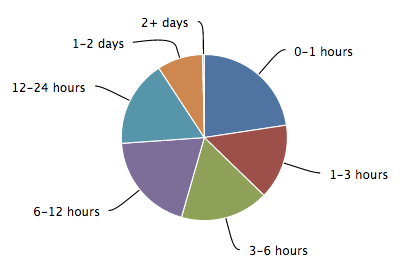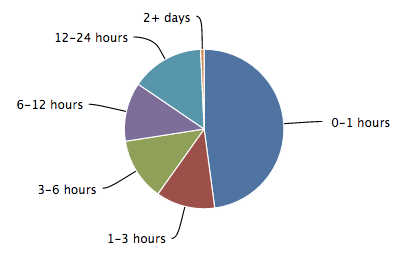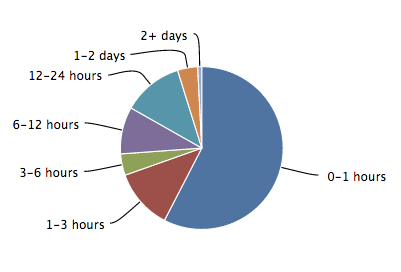Our First Weekend Warrior, New Weekly Digest And More: February Happiness at Buffer
Chief of Staff @ Buffer
We had a fantastic February, reaching exceeding our goals due to the very hard work from the Heroes. Read on for some of the changes we made and lessons we learned!
Numbers
Speed
Our goals for February were to hit 55% within 1 hour and 80% within 6 hours, a sizable but feasible improvement from January.
At the end of the month, we reached:
• 64% of emails within 1 hour
• 84% of emails within 6 hours
Volume
We sent 9,800 replies in February, roughly the same as January, in order to assist 5,400 customers. Of these, 1,400 generously took the time to give us a happiness rating (via Hively), earning us a 95% happiness percentage. We also saw a decrease in tweets, sending 3,900 total.
Now delivering more weekend happiness
A huge factor in our improved numbers this month was our weekends. In November, we identified that the weekends were tough days for our customers, as they often didn’t hear back from us until Monday morning. (Or Sunday night, since Åsa‘s Monday morning thankfully comes a bit earlier in Australia!).
We were lucky to bring on an enthusiastic and hard-working “Weekend Warrior” who works Fridays through Tuesdays. He’s currently in his “Buffer Bootcamp” and we saw a huge difference immediately once he was delivering happiness alongside our current Happiness Heroes.
Here’s the progression of the weekends after bringing him on board. (Dark blue = good on Help Scout‘s shiny visuals.)
January 25/26, 314 total replies; before our weekend warrior started:

February 15/16, 279 total replies; halfway through the “ramp up” month:

February 22/23, 374 total replies; making a huge difference!

We’re really excited to bring on another Weekend Warrior in another timezone in March and continue this trend. :)
A few other key schedule changes also helped us reach new heights in February, including some very early morning and weekend hours from Åsa, Mary and Adam.
Weekly Digest
When the product team at Buffer started working on the idea of a “weekly digest,” we got really excited. Anything that gives people more (or clearer) information about what they’re doing that’s working, and not working, and how they can improve, is awesome.
As with all of our emails, we encouraged folks to hit reply and talk to us. We love hearing feedback on changes, because usually we launch “version 1” and dive straight into how we can make each feature even better. Of course, any such customer communication increases our volume, and since we sent these on Mondays, we knew this had the potential to give our Happiness Heroes a very busy day.
While the volume did increase significantly on Mondays in February due to the digests, the replies were overwhelmingly positive and supportive. These types of emails energize the team and don’t always require much time, so the digests ended up helping with our stats. Special shout out to our Heroes who buckled in and crushed it on Mondays! One Monday, we reached 95% within 6 hours.
(To check out your own Buffer weekly digest, visit https://bufferapp.com/weekly-digest.)
“Everyone on support”
We continued bringing everyone in on support in February, including our Content and Growth teams. (The developers already rotate to help out with the trickier questions.) One example of this was the day that Leo helped out more than usual. Since he used to answer *all* customer emails, we joked that he “came out of retirement” to help us tackle emails (and will do so every few weeks). Unsurprisingly, he still shows us all how it’s done. It was also incredibly fun to bring the new voices into the rotation so that our customers can get to know everyone on the Buffer team.
Here’s Joel’s original email to the team about this change, in case it interests you to explore this “everyone on support” model and our reasoning! :)
Tagging
One experiment we started at the end of February was “tagging” every email in Help Scout. We currently track all reports of bugs in our Trello “bug board,” but haven’t consistently had a way to track what areas of the product are causing the most confusion. So, with that in mind, we launched a “tag everything” initiative. We’ve organized it like this:
Choose 1 or multiple tags, always:
“What area is the question about?”
(Some examples: posting, analytics, billing)
Choose only 1, if relevant:
“What platform is the customer on?”
(Some examples: Web, iPhone, extension)
Choose only 1, if relevant:
“What network is the question about?”
(Some examples: Facebook, LinkedIn, Google+)
We spent a few days last week “practicing” the tagging effort and getting the list of “areas” comprehensive. We’ll launch this fully for March, so we should have some good data to share next month!
Just from 2 days of tagging, we learned some interesting patterns. For example:
Facebook leads the other networks in support questions. It’s nearly double the next most frequent network mentioned.
We get an overwhelming percentage of our questions from web users. We get 5 times more questions about the web interface than all mobile and third party combined.
Posting is causing a fair amount of confusion, as it leads the questions with 34 questions about posting just in 2 days. For contrast, “analytics” has 2.
That’s just a glimpse into the sorts of facts we can glean from this exercise. Stay tuned next month for more of what we’ve learned!
Sacrifices: Scaling back on “love tweets” and live chat
Some sacrifices we made for our email numbers this month were Olark and what we call “love tweets,” which are wonderful, kind, happy tweets about Buffer that don’t include a question or necessarily ask for a reply. This change pains us, because we love to reply to each tweet about Buffer. In order to get through the volume, we made the decision to give this a try.
In February, we saw a 32% decrease in number of tweets sent, and a 13% decrease in number of tweets received. This is a bit of a chicken-and-egg question. It’s possible that we got fewer @ replies because we started fewer conversations (because we replied to fewer initial mentions), but it also seems likely that some of the incoming volume decrease is due to other factors, which means we had fewer to reply to.
Either way, sending 1700 fewer tweets in a month is like getting back roughly 2 Happiness Hero hours each day. This experiment, while sad, does seem to be saving us a bit of time while we continue to hire. :)
Similarly, we scaled back on live chat in order to focus on the inbox. In total, we had only about 100 conversations through Olark in February. We intend to continue to push forward in live chat as we grow.
Thanks for reading! As always, we’d love to hear any questions or comments below or at @buffer! :)
Try Buffer for free
140,000+ small businesses like yours use Buffer to build their brand on social media every month
Get started nowRelated Articles

Note: This is the quarterly update sent to Buffer shareholders, with a bit of added information for context. We share these updates transparently as a part of our ‘default to transparency ’ value. See all of our revenue on our public revenue dashboard and see all of our reports and updates here . It's been quite the y

Editor’s Note: Thanks for checking out this post! We’ve released our updated 2021 pay analysis here. You can’t improve something if you don’t know that it needs to be improved. That was very true for us four years ago when we first started looking into equal pay at Buffer. We have long used a salary formula to determine all of our salaries – the same role in the same part of the world receives the same salary. That m

Ever since the world got turned upside down by COVID-19, it’s been “business as unusual” for everyone – Buffer included. I sent this update out to Buffer’s investors one week ago. I hesitated on whether to share it more widely, as I know a lot of companies have been impacted more severely in these times. That said, I believe it makes sense to lean into our company value of transparency, since there may be some companies this could help, and it shows Buffer customers that we will be around beyon